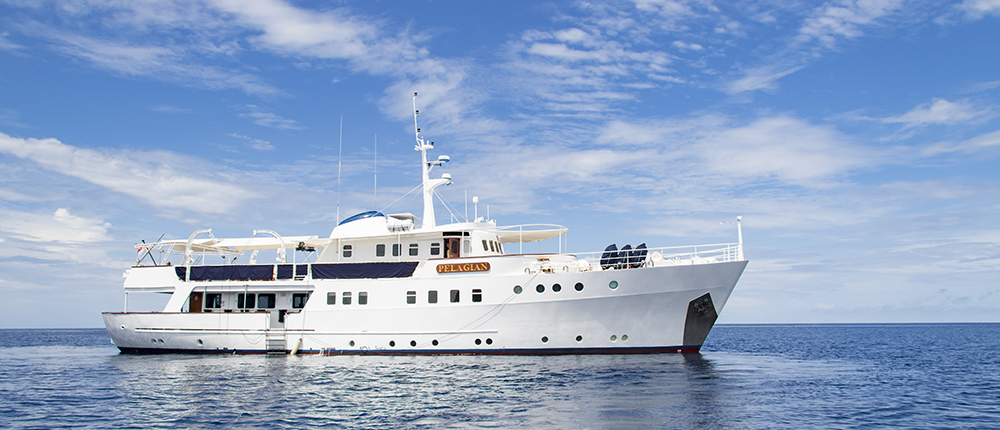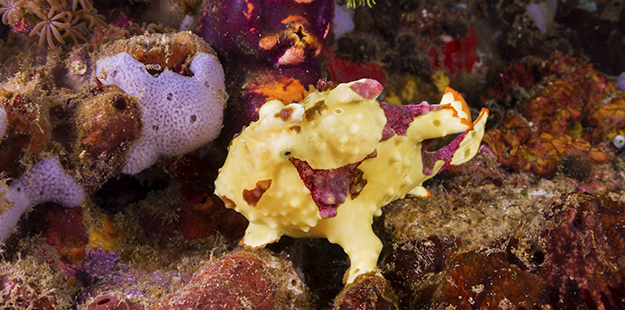Pelagian liveaboard, Beyond the Muck
Cruises aboard our luxury liveaboard take in a broad range of underwater adventures
Many of our guests add an extra dimension to their diving holiday by combining time at Wakatobi with a liveaboard cruise on the Pelagian. This 115-foot/35m luxury dive yacht departs from the resort to travel through a broader swath of the bio-diverse Wakatobi archipelago and the southern portion of Buton Island. For many, a highlight of the Pelagian’s seven-day itineraries are the unique muck dives in Buton’s Pasar Wajo Bay. But these same trips offer much more than muck, and include an exciting range of underwater environments from massive atolls and steep walls perforated by overhangs to fish-laden seamounts.

Guests have a relaxing lunch at the resort while the Pelagian crew prepares for their cruise. Photo by Didi Lotze
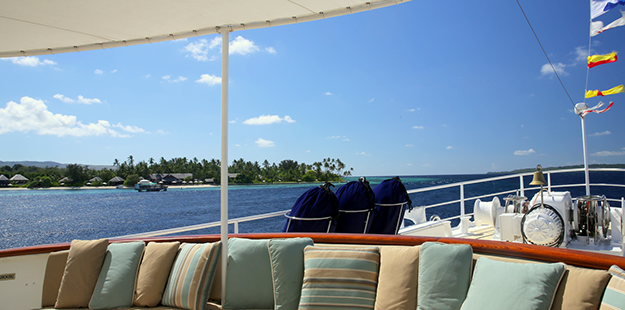
Pelagian heads out from the resort mid-day for an afternoon warm up dive or two. Photo by Wakatobi Resort
The big atolls
Pelagian cruises leave from the resort, with the yacht’s crew taking care of all gear and luggage transfer, leaving guests free to linger over lunch or enjoy a bit of beach time. After a mid-day departure, day one includes afternoon warm up dives on favorite sites within the marine preserve. Overnight, the Pelagian heads west of the Sawa reef to the expansive atolls of Karang Kaledupa and Karang Kapota, which are the largest such formations in Indonesia.
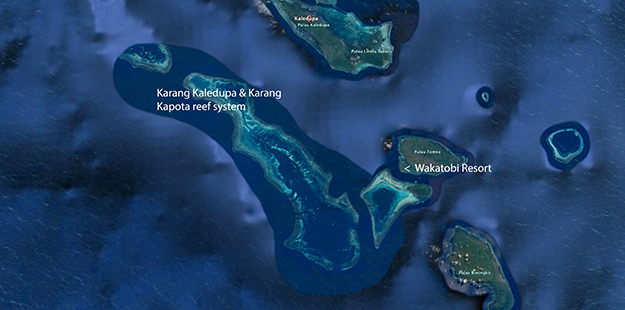
The coral atolls of Karang Kaledupa and Karang Kapota are a remote reef system that few divers ever have the opportunity to visit. Photo by Google Earth
The coral-fringed shoals of these atolls are home to some of the region’s most colorful and dramatically-contoured reefs. The tops of these formations rise to within a few meters of the surface, creating opportunities for long multi-level dives. The shallows are thick with dense and diverse coatings of both hard and soft corals, while the adjacent slopes and walls that plunge into the depths showcase an equally broad assortment of vibrant-colored soft coral trees and gorgonians resplendent in red, orange, pink and yellow hues. With visibility that typically exceeds 35-40 meters, these sites serve up dramatic big-picture views, and are often visited by blackfin barracuda, sea turtles and eagle rays.
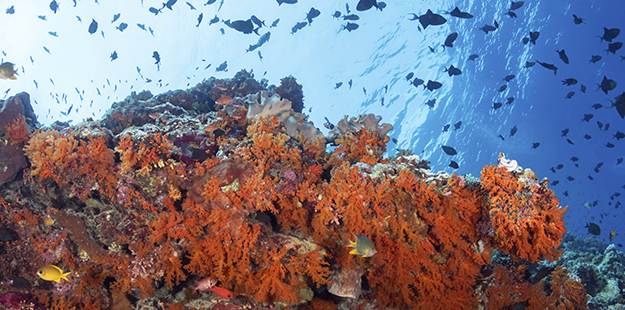
Colorful, lively reefs, clear water, and dramatic underwater topography is what the outer reefs of Wakatobi is all about. Photo by Walt Stearns
Also in the area are a number of open-water pinnacles. A typical example is the Wangi seamount, on which divers encounter a pinnacle that rises precipitously from the depths to within 10 meters/33 feet of the surface. After exploring this formation, divers then follow a connecting ridge to an even more dramatic pinnacle that soars to within 4 meters/13 feet of the surface. Schooling bigeye trevally, snappers, tuna and turtles often circle these underwater mountains, and their faces are covered in vibrant growths of fan corals, soft corals and critter-housing bushes of halimeda algae. Divers who take a closer look into the numerous crevices that riddle these pinnacles will a wealth of macro treasures such as pygmy seahorses, mantis shrimp, orangutan crab, nudibranchs, juvenile wrasse and leaf scorpionfish.
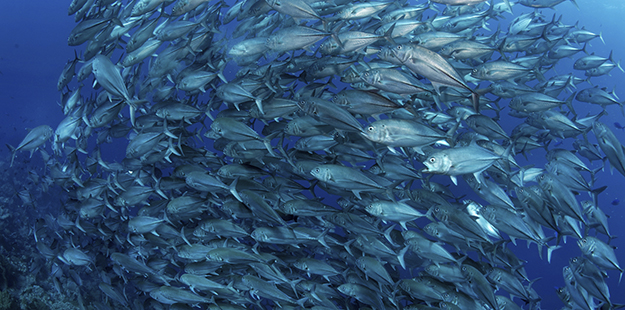
Bigeye trevally jack and other schooling fish often circle the underwater seamounts divers experience during a Pelagian cruise. Photo by Wakatobi Resort
Reefs, walls and pinnacles
After spending the middle day or two of each cruise in the critter-rich shallows of Buton’s Pasar Wajo Bay, Pelagian makes its way back towards Wakatobi Resort by way of Wangi Wangi, Hoga and Kaledupa Islands, making stops at shallow reefs and sites offering walls, more pinnacles and a chance for exciting drift dives. In this region, many reef profiles rise to within a meter or two of the surface, and showcase a variety of ecosystems as contours drop into deep water. A stand-out site near Wangi Wangi is Komang Reef. This elongated stand-alone sea mound comes alive with vibrant growths of soft corals, large sponges and an abundance of large sea fans. Schooling fish gather around this open-water oasis, and on tide changes it may be visited by rays, tuna, trevally and blacktip sharks. Aptly named Fishmarket is another pinnacle known for the high numbers of schooling fish it attracts, including a rather huge school of blackfin barracuda. The site’s unique terrain combines a steep wall with two deep ravines and a detached pinnacle that rises to within 10 meters of the surface.

Komang Reef features vibrant growths of soft corals, brilliant sponges and an abundance of large sea fans. Photo by Walt Stearns
More underwater treats await around Hoga Island. For a relaxing change of pace, divers might visit the large, sand-bottomed bowl known as Coral Garden, which is sheltered between two sloping walls of huge branching corals. One side of this bowl rises to a tall ridge, while the other end is open to deep water, where a wall plummets into the depths. Some of the area’s fishiest dives take place on pair of conjoined pinnacles, where divers can join throngs of schooling fish both large and small, including fusiliers, trevallies, great barracudas and napoleon wrasse. A closer look at the pinnacles surface will yield nudibranchs, frogfish, well-camouflaged scorpionfish and other critters that can be seen during a 5m safety stop. Another favorite is Hoga Channel at high tide, when both visibility and fish life are at a peak. The moving water draws an abundance of marine life, and it is also a natural through-way for passing pelagics.


